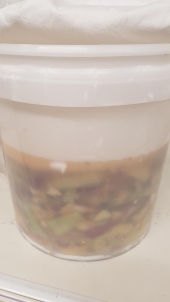Joe Fox wrote:The process you want to stimulate is first an alcoholic yeast based fermentation followed by an acetobacter fermentation to produce vinegar. Acetobacters need both alcohol and oxygen to produce vinegar.
Jay Angler wrote:I have read somewhere that to make Apple Cider Vinegar, you really need to make the Apple cider first as a separate step, and then the vinegar microbes ingest the alcohol and poop out vinegar ( CH3COOH ). The problem is that if I do this as two steps, there may be some demand for the Cider for direct consumption, not to mention the time and fussing required.
First of all, to clarify for anyone out there reading this thread who is unfamiliar with the process, when we talk about making "Apple Cider" in this context, we are talking about hard cider, i.e. alcoholic cider. And yes, I would totally be tempted to syphon off some of this alcoholic "vinegar stock" for direct consumption! ; ) Big fan of hard cider here.
For sure, the posts quoted above describe the traditional process for making vinegar, whether that be apple cider vinegar (ACV) or wine vinegar or rice wine vinegar or whatever: first ferment alcohol using yeast, then feed that alcohol to the appropriate bacteria to produce acetic acid. Which latter process, as Joe pointed out, requires oxygen.
Doubtless the production of vinegar as we know it was an unintentional off-shoot of the alcohol industry. When the hard cider or wine they were brewing got contaminated and exposed to a bit too much air, it turned sour. Selling off that "ruined" product for cheap, people soon learnt that it was a valuable cooking ingredient on its own.
However, there is absolutely NO NEED to follow this traditional process, except for tradition's sake. You can totally make ACV in one step. I've done it. In fact, I'm on my tenth batch or so by now. And the resulting product tastes just as good as any other ACV I've ever used. If anyone out there claims the traditional two step process produces better vinegar - and I don't even know that anyone does claim this - then you couldn't prove it by me.
I have not yet experimented with pomace/apple scrap vinegar, which is the original focus of this thread, because right now I don't have that feedstock. I just started by buying a gallon jug of fresh cider, which if you source it carefully can still be purchased for half the price of the same volume of good, raw ACV. I pitched a packet of purchased ale yeast and added some raw ACV (I like Braggs). You should always brew vinegar in a container that is low and wide. To maximize air exposure, and thus oxygen interchange, you want a wide mouth so to create the largest possible ratio of surface area to total volume. I didn't have such a container handy, so instead I split my cider into multiple small jars, which served the same function of increasing surface area. "Brewing" vinegar comprises nothing more than filling your containers, covering them with cloth to keep dust and flies out, and setting them aside for a month.
Two things happened. First, the added yeast and bacteria worked simultaneously to convert sugar to alcohol to acetic acid, and after a month I had lovely vinegar. Second, the little beasties combined to grow a SCOBY. So now, my already-simple-and-cheap process is even simpler and cheaper. I just chuck the SCOBYs from the last batch into some fresh apple cider, recover, and brew anew.
To be more precise, I cut my SCOBYs into chunks and toss those into fresh apple cider for the next batch. As anyone experienced in brewing kombucha knows, your SCOBY multiplies, growing fatter and forming baby SCOBYs. You only need a little for reuse, so you harvest a certain amount of excess SCOBY with every batch along with your vinegar. I throw my excess into the fridge, where it seems to keep fresh indefinitely, and blend them into fruit smoothies. I might also feed them to livestock if I had any.

 5
5




 4
4




 3
3




 2
2




 4
4




 3
3




 3
3




 3
3





 4
4




 4
4




 8
8




 6
6




 7
7









